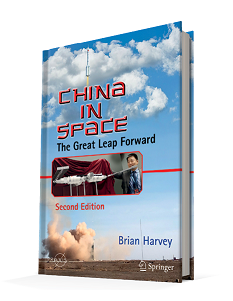It has long been suggested that, geopolitically, the 21st century will be the ‘Chinese Century’. At the dawn of the century’s third decade, the jury is very much still out on whether this predicted dominance will include space exploration and development, but with a gradually increasing Chinese launch rate and increased participation in international space conferences speculation is rife.
An indication of China’s space ambitions is derived from a study of history, which is where this author excels. In his fourth book in a series on the Chinese Space programme, Brian Harvey covers everything from satellite applications to launch vehicle development, while focusing on “China’s biggest space construction project” - the China Space Station - and the nation’s “ever-expanding ambitions across the solar system”. Although this sounds a bit like the premise for a science fiction drama, much of the latter will feature unmanned scientific spacecraft; moreover, the author is clear to point out that there is no hint of another space race and that China will move forward at its own pace.
The book itself is divided into nine chapters and provides a comprehensive and readable account of the Chinese space programme in a historical context. Although there is plenty of academic rigour – with 40-odd pages of glossaries, appendices, a bibliography and an index – the author never forgets that his readers may not be ‘rocket engineers’: “To an outsider”, he suggests, “all rockets, being rocket-shaped, appear to have the same means of propulsion, but there are many important distinctions between them” (he goes on to explain solid and liquid propellants). The volume is well illustrated with colour photos, most of which – in stark contrast to books on western space programmes – will be new to the majority of readers.
As with most history texts, the book is arguably most interesting when the author allows his experience and opinions to show through. While noting “some honourable exceptions”, Harvey is scathing in his criticism of western observers who “responded to Chinese space developments with a mixture of puzzlement, patronizing put-downs and dismissal”, suggesting that China’s hardware was “alternately primitive or imitative”, even “stolen”. By contrast, we learn that China’s “fourth white paper” on space (published in 2016) followed President Xi Jinping’s endorsement of a number of timelines for China’s development, which included being “one of the most innovative nations in the world by 2020…the leading innovator by 2030…and the world-leading power in science and technology by 2049”, the centenary of the founding of the People’s Republic of China.
Precisely how this vision will translate into space-related funding is unclear, but the volume’s cover text summarises the situation well: “China’s space programme is one of the least well-known, but [the nation] is poised to build a large, permanent space station, bring back lunar rocks, assemble constellations of communications satellites and send spaceships to Mars, the moons of Jupiter and beyond…In space, China is the country to watch”. Observers of the ‘Middle Kingdom’ would do well to start with this book.











